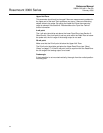
Reference Manual
00809-0100-4811, Rev CA
February 2006
Rosemount 3300 Series
4-10
Probe Type
The transmitter automatically makes an initial calibration based on the type of
probe that is used. This parameter is pre-configured at factory and only needs
to be set if the probe is changed to another type. Choose one of the following
options:
• Rigid Twin
• Flexible Twin
• Coaxial, Coaxial HP, Coaxial HTHP
• Rigid Single, Rigid Single HTHP, Rigid Single PTFE
• Flexible Single, Flexible Single HTHP, Flexible Single PTFE
NOTE
Flexible and Rigid probes require different radar electronics and can not be
used with the same transmitter head.
Product Dielectric
For interface measurements the dielectric constant of the upper product is
essential for calculating the interface level and the upper product thickness.
By default the Product Dielectric parameter is about 2.
If the dielectric constant of the lower product is significantly smaller than the
dielectric constant of water, you may need to make special adjustments. See
section “Interface Measurements for Semi-Transparent Bottom Products” on
page 6-5 for further information.The dielectric constant of the product is used
for setting the appropriate signal amplitude thresholds, see Section 6: Service
and Troubleshooting for more information on amplitude threshold settings.
Normally this parameter does not need to be changed for level
measurements. However, for some products measurement performance can
be optimized by setting the proper product dielectric constant.
The Rosemount Configuration Tool (RCT) software includes a Dielectric Chart
which lists the dielectric constants of a wide range of products. RCT also
includes a tool which allows you to calculate dielectric constants based on
measurements of the Upper Product Thickness.
Vapor Dielectric
In some applications there is heavy vapor above the product surface having a
significant influence on the level measurement. In such cases the vapor
dielectric can be entered to compensate for this effect.
The default value is equal to 1 which corresponds to the dielectric constant of
vacuum. Normally this value does not need to be changed since the effect on
measurement performance is very small for most vapors.
HART Comm
1, 3, 2, 3
HART Comm
1, 3, 3, 3
HART Comm
1, 3, 3, 2


















